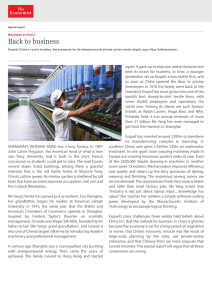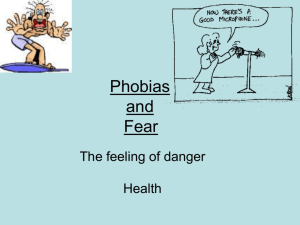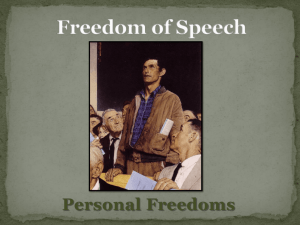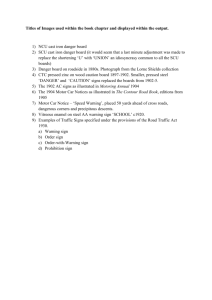A Community in the Wildland-Urban Interface María Cecilia Ciampoli Halaman
advertisement
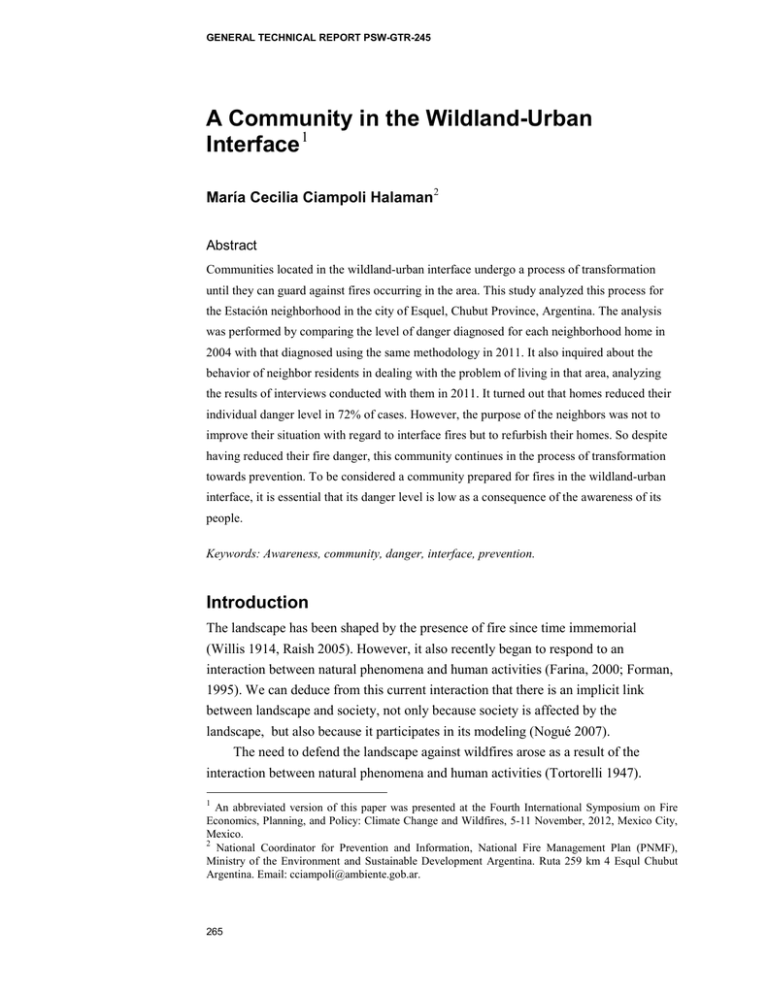
GENERAL TECHNICAL REPORT PSW-GTR-245 A Community in the Wildland-Urban Interface 1 María Cecilia Ciampoli Halaman2 Abstract Communities located in the wildland-urban interface undergo a process of transformation until they can guard against fires occurring in the area. This study analyzed this process for the Estación neighborhood in the city of Esquel, Chubut Province, Argentina. The analysis was performed by comparing the level of danger diagnosed for each neighborhood home in 2004 with that diagnosed using the same methodology in 2011. It also inquired about the behavior of neighbor residents in dealing with the problem of living in that area, analyzing the results of interviews conducted with them in 2011. It turned out that homes reduced their individual danger level in 72% of cases. However, the purpose of the neighbors was not to improve their situation with regard to interface fires but to refurbish their homes. So despite having reduced their fire danger, this community continues in the process of transformation towards prevention. To be considered a community prepared for fires in the wildland-urban interface, it is essential that its danger level is low as a consequence of the awareness of its people. Keywords: Awareness, community, danger, interface, prevention. Introduction The landscape has been shaped by the presence of fire since time immemorial (Willis 1914, Raish 2005). However, it also recently began to respond to an interaction between natural phenomena and human activities (Farina, 2000; Forman, 1995). We can deduce from this current interaction that there is an implicit link between landscape and society, not only because society is affected by the landscape, but also because it participates in its modeling (Nogué 2007). The need to defend the landscape against wildfires arose as a result of the interaction between natural phenomena and human activities (Tortorelli 1947). 1 An abbreviated version of this paper was presented at the Fourth International Symposium on Fire Economics, Planning, and Policy: Climate Change and Wildfires, 5-11 November, 2012, Mexico City, Mexico. 2 National Coordinator for Prevention and Information, National Fire Management Plan (PNMF), Ministry of the Environment and Sustainable Development Argentina. Ruta 259 km 4 Esqul Chubut Argentina. Email: cciampoli@ambiente.gob.ar. 265 GENERAL TECHNICAL REPORT PSW-GTR-245 Today this need is increasing for forest areas surrounding urban centers (Sonner 1994), where wildland-urban interface (WUI) fires occur, (Velez 2000). In the WUI, the frequency and threat of fires increase as the population growth rate increases (SDSyPA PNMF & BCFS 2002). However, the local population is usually not aware of the existing danger (Farías2009). Prevention is the key, and like any initiative it must be carefully planned to be successful (Chile Region VIII, CONAF 2006). In Argentina, a guide has been developed for the prevention of interface fires. Using this guide, the wildland-urban interface area called the Estación neighborhood, located in the city of Esquel in the Argentinean province of Chubut, was characterized in 2004. To address the prevention of interface fires in the Estación neighborhood, in 2004 a diagnosis was made of the situation, as this is the first planning step. The diagnosis consisted of an assessment of the vulnerability of homes to fire using standard criteria. At that same time (2004), the city of Esquel began making progress in terms of their building structures (Schulz 2012, p.c.), although it didn’t for several years around the specific theme of interface fires (Epele 2012, p.c.). For this reason and at the initiative of the local fire service to resume the analysis of the problem (2011), it began to reassess the danger posed to the homes in the Estación neighborhood, considered a pilot area. Se comienza a vislumbrar la iniciativa de la comunidad de Esquel, apuntando hacia la preparación contra los incendios que se producen en el área de interfaz urbano-forestal. One is beginning to see evidence of the Esquel community initiative at work, as the area moves toward preventing fires from occurring in the wildland-urban interface area. Objective The objective of this study is to determine if a community is prepared for wildlandurban interface fires, by analyzing the transformation process of the Estación neighborhood. Specific Objectives 1. To determine if there was a reduction in the fire danger level for homes in the selected interface area between 2004 and 2011. 2. To determine the behavior of area residents regarding the interface fire 266 Proceedings of the Fourth International Symposium on Fire Economics, Planning, and Policy: Climate Change and Wildfires danger. Methodology Study Area Esquel is the central city in an area that extends into the western region of the province of Chubut, between 42° 54' and 43° lat. South, on the eastern fringe of the North Patagonian Mountain Range. The city has about 30,000 people within its area of influence. Economic activity is concentrated in three corporate organizations: the Sociedad Rural (Rural Society), the Cámara de Comercio, Industria, Producción y Turismo (the Chamber of Commerce, Industry, Manufacturing and Tourism) and the Cámara de Prestadores de Servicios Turísticos (Chamber of Tourism Service Providers). The city has four bank branches. The region has a cold-temperate climate, with rain and snow during the winter months. Average annual rainfall in Esquel is 590 mm. Winds are generally classified as moderate to severe, with maximum wind speeds occurring in the spring and summer and prevailing winds from the west-southwest. In the Esquel area, the valleys are oriented northeast to southwest. The municipal ejido, or common land, of the city of Esquel is located in a strip that constitutes an ecotone zone, a transition area between cold-temperate forests to the west in the Andes and the Patagonian steppe to the east. Protection against wildfires in the Esquel region is the responsibility of specific fire management agencies: provincial, regional or national depending on the magnitude of the event. Among the most noteworthy are the Provincial Fire Management Service of Chubut (SPMF) and the National Fire Management Plan (PNMF) of Argentina. Suppression of wildland-urban interface fires involves not only the pertinent forest fire agencies but also other related organizations. Their coordination has been arranged for Esquel and surrounding villages through interagency plans (Institutional Coordination Plan 2010-2011). The Estación neighborhood containing the study area is one of the interface neighborhoods of the city of Esquel (Figure 1). The area itself consists of the seven closest blocks to the woodland surrounding the Estación neighborhood. The topography of the neighborhood is very unique because it lies within the canyons belonging to Leonidas Alemán Hill. This location exposes the neighborhood to upward or downward airflows depending on the time of day (Dentoni and Muñoz 2001; APN unpublished), creating a powerful effect on fire behavior (Hirsch 1996). 267 GENERAL TECHNICAL REPORT PSW-GTR-245 Another fire danger factor for the neighborhood is the surrounding vegetation, specifically an approximately 24-h, city-owned stand of pines (Pinus ponderosa Douglas ex Laws) with high-density planting (CIEFAP 2001). Figure 1—Aerial image of Estación neighborhood. Source: Sub-secretary of the Environment for the Municipality of Esquel 2004. The neighborhood is classified as low-income residential (Esquel SEAS 2001). While most of the houses have basic services, namely electricity, water and gas, there are some exceptions. There are also troubled areas and ones occupied by illegal settlements bordering the neighborhood. The buildings are mostly stable, with well-finished foundations and doors and windows. Durable materials and proper masonry characterize their construction. However, there are also some sub-standard homes and some that do not even have direct access from the street, making it necessary to cross a neighbor's property to access the dwelling in question. The families generally consist of five or six members. Both parents work and most receive a state subsidy. The average monthly income is about $ 3,000 (Argentine pesos, equivalent to about 500 euros), with most men working in construction and most women as housekeepers. State aid includes receiving assistance for food and heating. Methods 1. The results of the danger assessment carried out on homes in the Estación neighborhood in 2004 were compared with those of the 2011 one. The comparison 268 Proceedings of the Fourth International Symposium on Fire Economics, Planning, and Policy: Climate Change and Wildfires was made to determine similarities or differences in the overall degree of danger between the two assessments (2004 and 2011) for each of the 53 homes, considering also the criteria by which that danger level was obtained. The criteria were also reclassified according to the difficulty in implementing them. The procedure adopted for both assessments is detailed in the respective studies (Ciampoli Halaman 2004, 2011); it should be noted that it was proposed in the guide for interface fire prevention in Argentina (SDSyPA PNMF & BCFS 2002). The criteria reclassified according to the degree of implementation difficulty are presented in the table below (see Table 1). 1. Simple measures: only require the owner’s will to be done. 2. Medium measures: require some monetary investment in addition to the owner’s effort. 3. Structural measures: require extensive restructuring to be implemented. These recommendations were proposed for the Estación neighborhood among other areas of the province of Chubut. Table 1—Housing assessment, and simple, medium and structural measures with their respective recommendations. Measure Criterion roof cleaning Simple stacked firewood and combustible material services protective home measures conifer forest cover lot occupation Medium access Special factors (Sprinklers, Extreme forest fuel load, Deficient home indication). house location Structural roofing material cladding material Special factors (Access, windows, bridge capacity). 269 GENERAL TECHNICAL REPORT PSW-GTR-245 2. The information gathered in 46 interviews with neighborhood residents in 2011 was analyzed in order to determine their behavior with respect to fire danger. The analysis consisted of identifying the survey questions pertaining to the subject in question and classifying their answers in percentage terms. The interview technique used was that of directly interviewing the neighbors on an individual basis (CONAF, 2006), supported by leaflets delivered to every neighbor interviewed (Ciáampoli Halaman 2011). Results 1. A reduction in fire danger between 2004 and 2011 was determined for the homes in the interface area of the Estación neighboorhood in Esquel, Chubut, Argentina. Of the 53 homes compared, 72% scored lower in 2011 than in 2004. Of these homes that decreased their danger level, 51% were classified in a lower category by one level than in the previous assessment. Of the criteria evaluated: Simple measures were generally followed: roofs were cleaned, firewood or combustible materials were moved away from homes or directly eliminated, and urban trees were pruned to avoid contact with power lines. In terms of medium measures, some were improved and others not. Conifer forest cover decreased in value for all of the homes, since the stand was harvested in 2011, and lot occupation fell, as many of the substandard buildings that existed in 2004 were not found in 2011. It should be noted, however, that the access situation remained unchanged in virtually all cases. Regarding structural measures, improvements were also found in some criteria but not in others: roofs were generally replaced with new ones made of better materials, the location of the homes in virtually all cases remained the same, and large windows facing the forest increased the danger of several homes. 2. An analysis of the interviews revealed that six questions specifically addressed the fire danger issue. Those questions are presented below along with the summarized results of the responses given by the 46 neighborhood residents interviewed, classified as a percentage. 1) Respondent's awareness of the fire danger in his/her living area 91% of respondents replied that they knew about the danger that exists in their area. It should be noted that of the remaining 9%, half had resided there for only a few months and the other half had also not lived there for a long time. 2) Possession of a vehicle for evacuation 73% of respondents answered negatively. It should be noted that of the 37% 270 Proceedings of the Fourth International Symposium on Fire Economics, Planning, and Policy: Climate Change and Wildfires who do have their own transport, the vast majority use it to travel to their workplace so if there is an evacuation it is quite possible that the vehicle will not be available for that purpose at the home. 3) Knowledge of the contact number in case of fire 78% claimed to know the number to call. It should be noted that in all cases respondents referred to the number of the volunteer fire department, so even if they detected a fire that started in the forest they would call the volunteer fire department. 4) Personal experience with the damage or effects caused by a forest fire, either on one’s interests or property. 7% of respondents said they had been affected by fire during the time they had lived in the Estación neighborhood. This result is noteworthy because according to surveys, the average number of years that residents have been living in the Estación neighborhood is 14. Therefore, except for four isolated cases, the rest of the neighbors were there when the La Zeta Hill fire occurred that affected the Estación neighborhood stand on March 4, 2007. Figure 17: schematic of the fire that occurred on March 4, 2007 at La Zeta Hill. 5) Preventative measures taken by residents at their homes 76% said they had not taken any action. This result includes most of the respondents who said they had been affected by fire. 6) Carrying out of green garden waste burns 58% of respondents answered negatively. It should be noted that local residents know that the sanctioning authority for conducting burns is the institution to which the interviewers belong. Of the 42% that do perform waste burns, the vast majority said they have no other choice due to the lack of a collection service. The responses of the interviewed neighbors were also linked with the households that decreased their danger level between assessments, finding that of the 38 households that decreased their individual danger, 56% of them have neighbors who said they had not taken any action in this regard. Discussion While 72% of households decreased their individual danger, there was no direct contribution to this reduction by their neighbors. Direct contribution in this case refers to actions planned and carried out for this purpose. Regarding behavior, some peculiarities were detected. Namely, although most residents (over 90%) claimed to know they were living in a fire danger interface area, most (76%) did not take any preventive measures in this regard. This last figure includes more than half of the neighbors of the households that decreased their 271 GENERAL TECHNICAL REPORT PSW-GTR-245 danger level between assessments. They said they had not been endangered by fire, even though most of them were already living there when the La Zeta fire that affected the Estación stand occurred there in 2007. As for the few neighbors who did recall being threatened by the fire, most of them (67%) were part of the group that did not take any actions to reduce the danger to their homes. Conclusions While issues of a structural, environmental management and urban planning nature have evolved favorably in terms of reducing fire danger in the Estación neighborhood, residents show contradictions in their response to the problem. Therefore, this community continues in the process of transformation towards prevention. One can thus see the dominance of the social aspect in structural issues and of environmental improvement works in the problem of fire in the wildland-urban interface, as no initiative can be sustained without the involvement of the residents themselves. To be considered a community prepared for fires in the wildland-urban interface, it is essential that the danger level is low as a consequence of the awareness of its inhabitants. References Administración de Parques Nacionales (APN). Delegación Regional Patagonia. Subprograma Ecología del Fuego. Inédito. Protección de viviendas y estructuras en incendios mixtos y de interfase. Ciámpoli Halaman M.C. 2004. Caracterización del Peligro de Incendio en la Interfase Urbano Forestal. Tesis de grado. Facultad Ingeniería Forestal. Universidad Nacional de la Patagonia San Juan Bosco. 49p. Ciámpoli Halaman M.C. 2011. Hacia una Comunidad Prevenida ante el Peligro de Incendio Urbano Forestal. Tesis de Master en Medio Natural, Cambio Global y Sostenibilidad Socio Ecológica. Universidad Internacional de Andalucía. España. 101p. CIEFAP. Dirección de Medio Ambiente y Espacios Verdes – Municipalidad de Esquel. Universidad Nacional de la Patagonia San Juan Bosco Facultad de IngenieríaCátedra de Dasometría. 2001. Inventario Forestal. Forestaciones Comunales Esquel. 47 p. Dentoni, M.C., Muñoz, M. 2001. Glosario de Términos Relacionados con el Manejo del Fuego. Plan Nacional de Manejo del Fuego. Secretaria de Desarrollo Sustentable y Política Ambiental. Argentina. 28 p. 272 Proceedings of the Fourth International Symposium on Fire Economics, Planning, and Policy: Climate Change and Wildfires Esquel Seas. 2001. Plan participativo de desarrollo local, social, económico y ambientalmente sustentable: documento final. Esquel: Universidad Nacional de la Patagonia San Juan Bosco. Farias, M.C. 2009. Report on fire culture in Argentina. Social representations of fire risk in an urban-forest interface – CIEFAP. Project Title FIRE PARADOX: An Innovative Approach of Integrated Wildland Fire Management Regulating the Wildfire Problem by the Wise Use of Fire: Solving the Fire Paradox. 33 p. Farina, A.2000. The cultural landscape as a model for the integration of ecology and economics. Bioscience, nº 50(4), págs. 313-320. Forman, R.T.T. 1995: Land Mosaics: The Ecology of Landscapes and Regions. Cambridge University Press, Cambridge, UK. Gobierno Regional y CONAF, VIII Región. 2006. Manual del profesional que trabaja en prevención de incendios forestales. Gobierno de Chile. Ministerio de Agricultura. CONAF. 32 p Hirsch, K.G. 1996. Canadian Forest Fire Behavior Prediction (FBP) System. User´s guide. Canadian Forest Service. Northwest Region. Northern Forestry Centre. Canada. 122 p. Nogue, J., Eds. 2007. La construcción social del paisaje. Editorial Biblioteca Nueva, SL. Madrid. Raish, C., González-Cabán A., Condie, C.J. 2005. The importance of traditional fire use and management practices for contemporary land managers in the American Southwest. Environmental Hazards Published, by Elsevier Ltd. Secretaria de Desarrollo Sustentable y Política Ambiental. Plan Nacional de Manejo del Fuego, Argentina. Programa de Protección de Bosques, Ministerio Forestal de British Columbia, Canadá. Agencia Canadiense de Desarrollo Internacional. 2002. Guía para la prevención de incendios de interfase en la República Argentina. Canadá. 72 p. Sonner, S. 1994. Forest homes drawing fire. The Spokesman-review. Tortorelli, L.A. 1947. Los Incendios de Bosques en la Argentina. Ministerio de Agricultura de la Nación. Dirección Forestal. Buenos Aires., Argentina. 231p Vélez, R. 2000. La Defensa de los Incendios Forestales - Fundamentos y Experiencias. Ed. Mac Graw Hill. Madrid, España. Willis, B. 1914. El Norte de la Patagonia. Comisión de Estudios Hidrológicos. Ministerio de Obras Públicas. República Argentina. Tomo 1, 500 p. 273
